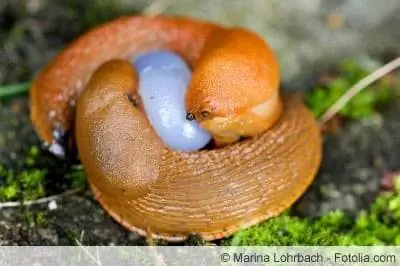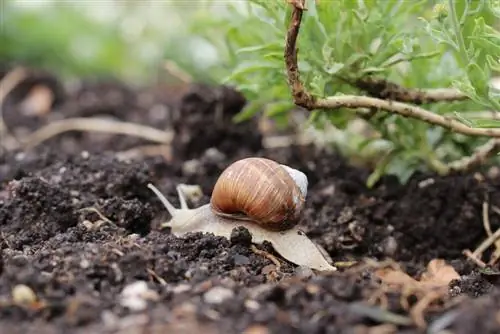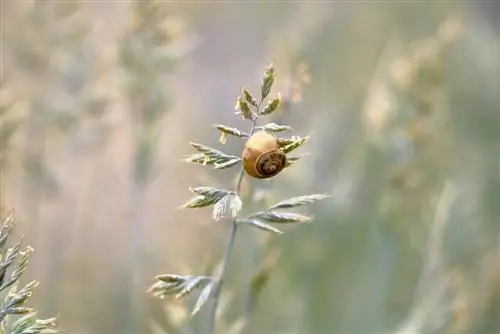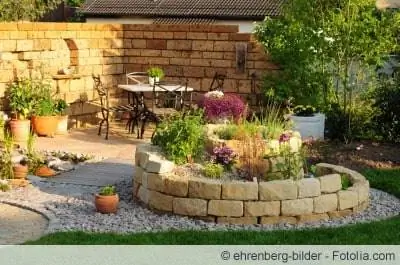- Author admin [email protected].
- Public 2023-12-17 03:39.
- Last modified 2025-01-24 12:45.
Snails are a pest. They can destroy half a vegetable crop or a lot of perennials in one night. In some years it is particularly bad when hundreds of snails appear in the garden and you can hardly keep up with collecting them. A snail fence can help protect the plants.
Snail traps like the beer trap are often recommended, but they then attract the slimes from the neighboring gardens and increase the problem rather than help. Chemical agents for vegetables are rather counterproductive and those who don't use poisons for vegetables usually don't want them elsewhere in the garden. Snail fences are a safe way to keep the pests away.
Snail fence for prevention
Prevention is always better than cure. The ideal is that snails don't even reach the eating plants they love. While the commercially available remedies against snails are only used once an infestation has been identified, fences don't even get that far. No snail has to lose its life.
Requirements for a snail fence
Snail fences have the task of preventing snails from climbing over them. They must meet certain criteria to be effective.
- A snail fence must be smooth and even
- Have steep walls
- It is ideal if the upper edge is angled outwards
- Fence height at least 15 cm (above ground), higher is even better
- Good materials are plastic and metal
- The snails find little or no support
- The protection must be complete. Every opportunity to slip through is used.
- The bottom edge of the fence must be deep enough in the ground to support the fence
- If necessary, use cords or wire to give the construction more support
- Plastic fences are inexpensive, but hardly effective
- Metal fences are more expensive, but usually more reliable
Metal snail fence

Metal snail fences are effective, but unfortunately they are usually quite expensive. You need a fairly high piece of sheet metal, because in order to have support, it has to be properly inserted into the ground and the upper edge must also be bent outwards. Hot-dip galvanized sheet steel with a zinc coating is ideal. The tray must be 35 to 40 cm high.10 cm are inserted into the ground, the fence should then be 15 cm high, the rest is bent outwards to prevent climbing over. It is bent before being put together and inserted into the ground. At a height of 25 cm, bend the sheet metal outwards and fold it, as the expert says. It is ideal to then bend the last cm inwards again, as this makes it much more difficult to overcome. Angles are attached to the corners to connect the individual elements. They only need to be 25 cm, 10 cm in the ground and 15 cm high. This is how the fence is screwed together.
- It's best to have the sheet metal cut to size at a hardware store or cut it to size yourself
- Four parts all around, which are screwed together using brackets, necessarily from the inside
- Bend a straight fold outward at a height of about 25 cm
- Connect all parts
- Dig the fence 10 cm deep so that the snails have no opportunity to undermine the fence
Copper snail fence
The copper snail fence won't win any beauty awards, but it serves its purpose. The advantage of this fence compared to plastic fences is that it does not require glue. Retaining clips are used and they hold much better. The individual fence elements remain connected.
Robin snails and all shell snails probably react best to the copper fence. Brown slugs can also be deterred quite well. Things get more difficult with the red slugs. They don't let anything scare them so easily. Some flinch, others crawl over it.
Tip:
What you need to know is that the fence only works once a patina has formed on it. This keeps snails away. In the first year this is not the case and the snails simply climb over it. So either you use older copper sheet or you have to let it oxidize outdoors for a year. As soon as the dark patina has formed, the snail fence is effective.
Copper wire is described by most users as ineffective, regardless of whether it is laid out horizontally or installed vertically. But there are also positive reports. The only thing that helps here is to try it out.
Advantages of copper fence
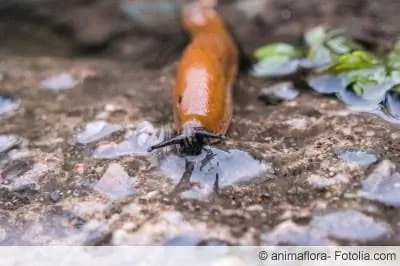
The copper strip contains substances that oxidize with the snails' mucous membranes. A narrow strip of copper is enough to keep the snails away. They don't even try to climb over it. However, the fence is ineffective when newly constructed. As described above, it takes time.
Building a snail fence
The metal plates for the copper fence are available at hardware stores. You can also have them cut to size there. With the copper fence, a much narrower strip is enough to keep the snails out.
- Join metal panels together depending on how large the fenced area should be.
- Apply mounting clamps for fastening.
- Place the strip around the bed without any gaps and secure it in place. It doesn't have to be buried so deeply in the ground, but it shouldn't fly away in the wind or be washed out when it rains.
- Smooth copper foil is also said to have a positive effect. You can get these at a craft store or a blasting shop. Snails wouldn't crawl over it either.
Attention:
Copper contains substances that are not safe for humans and pets. Dissolved copper is toxic even in small quantities. Over time, small amounts of copper can leach out and end up in the ground. Especially for vegetable beds, you should consider whether it really needs to be a copper fence.
Snail collar
In contrast to the snail fence, a snail collar protects individual plants. It is particularly useful during the budding period for plants that are particularly popular with snails. In this way, you can specifically protect individual plants in the perennial bed from being eaten away. Plastic is often used for these rings, but copper is also suitable. It is important to have open ground so that the snails cannot get over the fence via neighboring plants. It must be set up freely. You need one collar per plant.
- Bend a strip of copper to form a ring.
- Close this with retaining clamps.
- Place the ring around the plant and press something into the soil
- The ring should be generously sized so that parts of the plant do not soon protrude over it and then of course be eaten away.
Snails can quickly become a pest. Especially in wet years, they multiply en masse and can ruin your gardening season. Snail fences can be a great help, as can snail collars. They are easy to build yourself, whether made of plastic or metal. Copper snail fences help against snails as soon as they have developed a proper patina. Copper costs a lot to buy and if you're unlucky your fence will be stolen. There have been more and more copper thieves lately. You should also consider a copper fence around the vegetable patch, as copper particles can be washed out over time and end up in the soil. From there the path to the vegetable plants is not far. So, as with most things in life, there are two sides that need to be considered.

